Long before the bench press was the apple of every gym rat’s eye, in the days before drugged-up muscles, pills, powders, and potions ruled the world’s fitness scene, only one thing set the real men and women apart from the boys and girls—strength. The ultimate show of upper body strength was, and still is, the overhead press.
Legendary powerlifting coach Marty Gallagher once pointed out that if you left a barbell on an island populated by heretofore undiscovered natives and came back a week later, they would have figured out a way to put it over their heads. Dinosaur-training genius Brooks Kubik has noted that in the days before toning and shaping, people judged your strength first and foremost by how much you could press over your head.
There’s no doubt about it, overhead pressing is just plain cool. “To press a lot, you must press a lot.” This is an incontrovertible fact, delivered to us by Pavel’s landmark vehicle for world kettlebell domination Enter The Kettlebell. There’s no way around it—if you want to press heavy stuff over your head, you have to press heavy stuff over your head!
But variety is important, and sometimes, just sometimes, the detour is the way. More and more I’ve found that calisthenics strength training has been the key I’ve needed to launch me in new directions and to new heights in my iron practice, and the path in this instance started on the push-up.
The One-arm One-Leg Push-up and the Military Press
Not just any push-up, but the rarely seen and elusive one-arm one-leg push-up. I, like any self-respecting kettlebell fanatic, love the feeling of heavy iron over my head. But after years of fits and starts, successes and setbacks, I decided to take a much needed break from kettlebell pressing.
My journey began in March of 2012, a good nine months after my obsession with calisthenics training kicked off in full force, and right after attending and learning from Pavel and Dan John at the Easy Strength workshop. I decided then and there to seriously program bodyweight strength training and started Dan John’s 40 Day Easy Strength program to see how strong I could get from it. I decided to tackle the one-arm one-leg push-up, the weighted pistol, weighted pull-up, dragon flag, and the single-sided kettlebell rack carry.
After forty days of ignoring my nagging exercise ADD, I took a few days off and tested myself. I was beyond pleased with my results. Not only did I make massive improvements in all the exercises, but something unexpected happened: the 36 kg kettlebell—which previously sat on my chest and laughed at me every time I tried to press it—fired skyward the first time ever!
And what happened to me wasn’t a fluke either. My coach and mentor John Scott Stevens, SFG II, attended the Naked Warrior workshop with me in October and hadn’t touched his half bodyweight kettlebell (40kg) since then. I gave him a program to nail his one-arm one-leg push-up (which will appear in a few paragraphs), and that’s the only upper body pressing he’s been doing since then. On March 15—five months later—I asked him to test his 40kg press for the sake of this article and he nailed five reps in a row on his right arm—a lifetime personal record.
The Secret Sauce of Bodyweight Strength Training
Sitting back and looking at both Scott’s and my successes in the overhead press has elicited some observations that, every time I’ve tested, have proven over and over again to be correct—bodyweight strength training will teach you more about the discipline of building strength than any other method. That’s not just me saying it either. Pavel noted the same thing at his dynamite Naked Warrior certification last year.
So what benefits does bodyweight strength training hold for you and your iron practice? Among the many things, it boils down to one very simple thing—total tension.
Progressing through bodyweight-only strength movements is not as simple as adding weights—it’s about reducing leverage. Reducing leverage necessitates more full-body tension with each passing progression. With each increasingly difficult progression, leakages in tension are no longer mere leakages, they’re full-on roadblocks to you successfully completing the movement. Full-body tension is not just the goal, it’s the requirement.
Seeing as how this is our goal for improving our strength with kettlebells and barbells, leakages and weaknesses become crystal clear in an instant when the unforgiving pull of gravity keeps you grounded and humbled. Learning how to plug the tension leaks when they rear their head pays off in dividends once the lifting gets heavy and playtime is over.
With those basics established, your time has come. You may have run for a long time, but you can no longer hide from the benefits of calisthenics training.
Proper One-arm One-Leg Push-Up Technique
Before discussing programming, you’ll want to get your technique down, and YouTube University should not be your first choice for learning (unless you’re on my YouTube channel, of course, in which case, class is always in session).
Follow the tips below for each and every rep:
- Keep your shoulder pushed down—it’s a one-arm push-up, not a one-arm trap-up.
- Keep the crook of your elbow pointed forward (“screw your shoulder into its socket”).
- Get into the hollow position (squeeze your butt, flare your shoulder blades, and brace your abs for a punch).
- Kick your hip over to your working side. Much like a military press, having the hip under the working arm will support you in completing the movement.
- Get tight! Power breathe to get the necessary full-body tension, squeeze your non-working hand into a fist, and practice all reps—even the easier ones—like they’re your heavy ones.
Using the OAOL Push-up to Get a Heavier Military Press
As far as programming, you can thrive on very few reps of these per day and get ridiculously strong. Let’s keep things simple and use Dan John’s 40 Day program. Include an upper body pull, something for your lower body (squat/hinge), an ab exercise, and either something high-rep (swings/snatches) or (preferably) a loaded carry. I recommend loaded carries for the sake of your overhead press, but that’s just me. Your conditioning will likely drop during this program. Deal with it. It’ll be much easier to get it back after all the strength you build anyway.
As with anything we do at StrongFirst, progression is the name of the game. In most cases for feats of bodyweight strength, adding weight isn’t a viable option. The secret weapon to succeeding and progressing with one-arm push-ups is doing a miniature version of the movement—in this case, elevating your working hand and slowly reducing the leverage as you get stronger.
You’ll find a lot of weird push-up variations out there purporting to help you achieve your one-arm-er, but truthfully, the best and most results-producing method is the one above. It leaves nothing to chance and the only variable that changes is the leverage. Save the goofy push-up variations for your collection of party tricks.
Here is your program (listed as sets x reps):
Week 1:
- Monday – 2×5
- Tuesday – 2×5
- Wednesday – 5, 3, 2 (decrease elevation each set)
- Thursday – 2×5
- Friday – 2×5
Week 2:
- Monday – 2×5
- Tuesday – 6×1 (decrease elevation each single)
- Wednesday – 1×10 (very light)
- Thursday – 2×5
- Friday – 5, 3, 2 (decrease elevation each set)
Your 2×5 set should be at whatever height would serve as your 8-10 rep max. On days in which you decrease the elevation, decrease it just enough that you feel the difference, but not so much that an onlooker would think you’re struggling. All your reps should look the same, regardless of their difficulty level. Remember to apply the technique tips from earlier in the article.
This next part is optional, but honestly, it’s what I would have done if I could go back and do this all again. Walking over to your elevation and doing quality reps will work no matter what. But to more precisely groove the pattern and ingrain the movement into your body—not to mention build strength even faster—add the following specialized plank drill before each set:
Hold a five-second one-arm one-leg push-up plank at a lower elevation (ideally on the floor if you’re strong enough). Then, actively pull yourself into the bottom position—low enough that your shirt brushes the ground. Hold this position for five seconds, then relax. Shake out the tension, walk over to your elevation, and do your reps. Repeat on the other arm.
Here are a few excerpts from my first bout with this program:
- Day 1: 2×5 (mid-thigh level)
- Day 10: 5 (mid-thigh), 3 (knee level), 2 (below knee)
- Day 21: 2×5 (knee level)
- Day 26: 5 (knee level), 3 (below knee), 2 (above ankle)
- Day 36: 2×5 (below knee)
As you progress through the program, your easy sets should gradually progress closer and closer to the ground. Before you know it, one-arm one-leg push-ups will be yours.
From Bodyweight to Heavyweight
Simple? Yes. Boring? Oh, yeah. Effective? You’d better believe it. Add in stacked kettlebell rack walks at the end of your sessions to groove the rack position for your press and your target weight in the military press will shoot sky high faster than you can say “Power to You!”
Be sure at the end of each session to stretch out your hip rotators, QL, and abdominal muscles to keep your soft tissues happy and movable. I speak from experience when I say ignoring those things will come back to bite you in places you probably won’t enjoy.
One good press deserves another. It will be hard, but putting your kettlebells aside for a few months and conquering the one-arm one-leg push-up will likely be one of the best things you do for your press.
Go forth and be bodyweight strong, my friends.

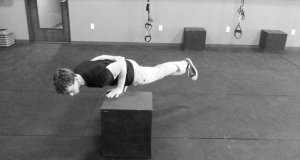
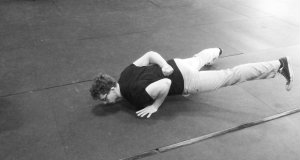
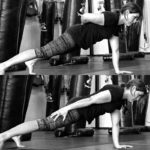
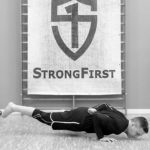

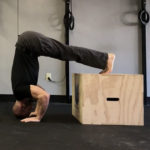
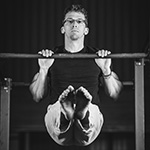


Can you do wide grip?
I think if you’re doing wide grip your foot definitely does need to lie flat for balance and you engage a lot more of your adductors and obliques to counteract the addition of the lateral forces. The first time I just tried the OAOL was with wide grip and I apparently was already all trained up for it, even doing it on my fingers that first day. (@srichterss) Epic feeling for sure. Everything Aleks is saying here explains the incredible tension required perfectly. My body was soooo tight after a few of these, it felt amazing.
does it count if my grounded foot rests with the inside of the foot touching the ground rather than on the toes?
I first read this article in September and being able to do straight 1-arm push-ups thought I would see just how much more difficult 1-arm/1-leg push-ups really were. Needless to say I nearly fell on my face. At that point I decided that I wanted to be able to do 1-arm/1-leg push-ups by my 40th birthday in ~10 weeks. My 40th Birthday was yesterday and with using a subset of the progessions listed as part of my typical warm-up for my other workouts was able to complete two 1-arm/1-leg push-ups per side!
I think I am going to continue working on these until I am able to do 5 per side, but felt I needed to express my thanks and satisfaction with the quality of information and goals that are provided in these articles as well as the blogs!
That is awesome!!! I am gonna work on these too. Fun and unique strength building here.
I don’t know why I never saw this before, but Jeff, that is awesome! Congratulations, and thank you for letting me know!
I assume you could try this approach with one arm chin-ups and pull-ip sad well using more of the POWER TO THE PEOPLE techniques (2×5) awesome article. Hope to hear more on bodyweight training.
Ladies and gents, Aleks is having some technical difficulties. He will answer your questions on http://www.strongfirst.com/forums/topic/questions-on-one-armone-leg-pushup-article/
Aleks,
I am impressed by your obvious dedication to sticking with a certain movement pattern despite not seeing success at the start. Like yourself, I was very unathletic and it took time to achieve some movements that are now relatively easy to perform. I am a full proponent of maintaining tightness throughout a specific movement in order to not allow for any energy leaks, as well, and advocate them for almost all bodyweight movements – especially those involving kettlebells as well. Great article!
So, with the 40 days, are there any rest days at all, or is it 40 days of straight work?
One-arm/one-leg pushup is so hard but feet-together version is more difficult for me. How do you think about feet-together version? Which version is good for big lift?
I agree, I would rather bring my feet closer together over time than lift a leg off of the ground.
Thanks for sharing.
How many reps/sets did you do for the other exercises?
I take it you repeated week 1 and 2 sequence?
I just tried basic GTG. But I think at a certain point, I should use more “conventional” training. I’m starting back on OAPs and pistols again. Thanks so much!!!
I learned from “Naked Warrior’, but I am going to try your advice and progressions. Thanks!!!